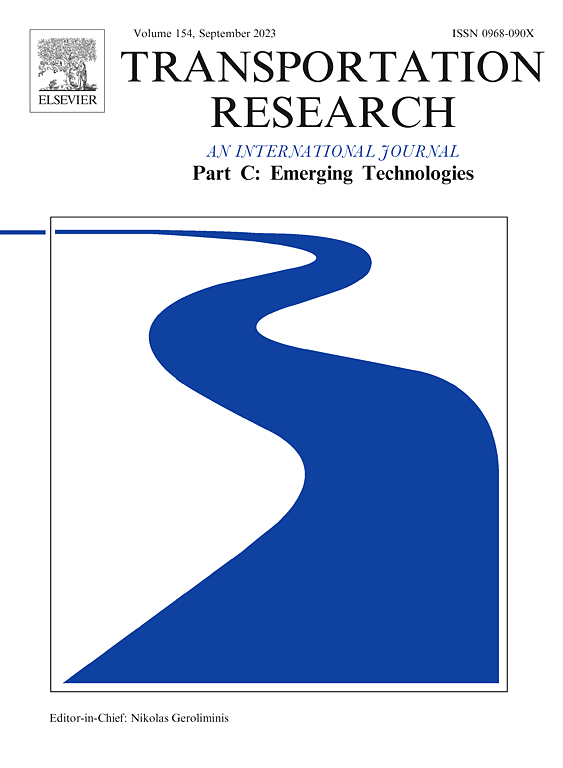Dynamic multi-region MFD stochastic user equilibrium: Formulation and parameter estimation in a large-scale case study
IF 7.6
1区 工程技术
Q1 TRANSPORTATION SCIENCE & TECHNOLOGY
Transportation Research Part C-Emerging Technologies
Pub Date : 2025-02-27
DOI:10.1016/j.trc.2025.105008
引用次数: 0
Abstract
Multi-region Macroscopic Fundamental Diagram (MFD) traffic equilibrium models have been developed as a more easily calibratable, maintainable, and computationally efficient alternative to traditional link-network traffic assignment models with full disaggregate network representation. There are four gaps in the research into these models that we highlight: i) the lack of stochasticity accounted for in the modelling of regional path choice, ii) the estimation of parameters of regional path choice models within the traffic equilibrium, iii) regional path choices being based on region travel times actually experienced (rather than instantaneous travel times), and iv) the paucity of real-life case studies. Motivated by these gaps, this paper presents a new dynamic multi-region MFD Stochastic User Equilibrium (SUE) model, and applies it in a real-life case study. The traffic dynamics are described by a new traffic propagation model utilising features of a space–time graph. Regional path choices can be based on region travel times actually experienced. The model produces continuous equilibrated regional path choice probability outputs, thereby facilitating the development of a rigorous statistical estimation procedure for calibrating parameters from tracked regional path choice data. This estimation procedure is operationalised in a large-scale and detailed multi-region MFD system, with 39 underlying rural and urban regions and 96 directional, superimposed motorway regions, 135 regions in total. Results provide empirical evidence to support hypotheses that regional path choice modelling should consider stochasticity, regional path overlap, multiple attributes, and experienced region travel times. Numerical experiments also demonstrate continuity, differences between the instantaneous and experienced dynamic models, relative insensitivity to the time-slice grain, and realism of the model.
求助全文
约1分钟内获得全文
求助全文
来源期刊
CiteScore
15.80
自引率
12.00%
发文量
332
审稿时长
64 days
期刊介绍:
Transportation Research: Part C (TR_C) is dedicated to showcasing high-quality, scholarly research that delves into the development, applications, and implications of transportation systems and emerging technologies. Our focus lies not solely on individual technologies, but rather on their broader implications for the planning, design, operation, control, maintenance, and rehabilitation of transportation systems, services, and components. In essence, the intellectual core of the journal revolves around the transportation aspect rather than the technology itself. We actively encourage the integration of quantitative methods from diverse fields such as operations research, control systems, complex networks, computer science, and artificial intelligence. Join us in exploring the intersection of transportation systems and emerging technologies to drive innovation and progress in the field.

 求助内容:
求助内容: 应助结果提醒方式:
应助结果提醒方式:


